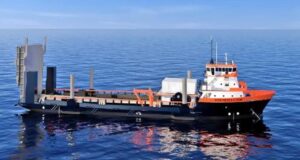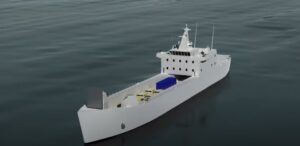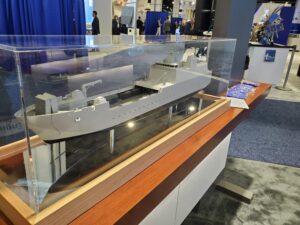The Marine Corps Warfighting Lab plans to start experimenting with a prototype landing ship this month after making modifications to a commercial Offshore Support Vessel (OSV).
The Marine Corps used Military Sealift Command (MSC) to contract for one modified OSV with Hornbeck Offshore Services
[HOS], making at a Stern Landing Vessel (SLV) to help experiment with the concept of the future Landing Ship Medium (LSM), previously called the Light Amphibious Warship. Ultimately, the Navy plans to lease and potentially buy three SLVs working on this experimentation.

This first vessel is named the HOS Resolution.
“There’s a demand and there’s a need to be able to move things in and around the Pacific, because primarily what makes things different in the Pacific than anywhere else we’ve operated recently, is the fact that it’s predominantly water. And because it’s water, we need surface vessels, air vessels, primarily to move things,” Jeff Tomczak, deputy director for science and technology division at the Marine Corps Warfighting Lab (MCWL), told reporters Monday.
“Conceptually, we’re looking at this ship – it’s an experimentation. You can call it a prototype. It’s very mature technology that’s out there,” he added.
Lt. Col. Tim Smith, MCWL science and technology logistics combat element branch head, detailed how the Navy made “significant modifications” to the base OSV design for Marine Corps testing.
The ship has a 12-foot draft, 6,000 square feet of cargo space, the capacity to hold 38 Marines and a commercial crew of 12 to 15 mariners.
The modified ship includes a large ramp to make it more beachable, several landing skegs and other materials to protect the rear ship rudders and props, and landing legs for stability to learn how SLVs work in surf conditions.
“We’ve reinforced the deck of the vessel so that it can carry everything in the Marine Corps inventory right now, up to a ratch with a loaded 40-foot container. I don’t think we’ll be doing that in the future, but we wanted to make sure that the service had the capability to experiment with and, if that was a requirement, be able to do so,” Smith said.
He noted the SLV can carry both normal and aviation gasoline because they plan for it to be able to support or experiment with unmanned aerial vehicles, Amphibious Combat Vehicles, “and then potentially do any of the future subsurface or low profile craft that we’re developing as well.”
“So we’re really trying to give the Marine Corps Warfighting Lab and the service at large the ability to experiment with a particular vessel and then across everything that we’re working, in addition to that space for future maneuver and logistics,” Smith continued.
Smith underscored the Navy and Marine Corps plan to receive the first vessel in March. They are funded for two more similar vessels, but have not gone through the procurement process for them yet. He said they expect to get the second and third SLVs in 2024, but they will go through the normal contracting process with MSC, with no guarantee HOS will win those too.

While these SLVs will be leased for “a couple years,” Smith confirmed the contract includes an option to ultimately buy the vessel.
“The unique thing about this lease is that we modified the vessel as well. So that was all wrapped up in – we didn’t just lease an SLV that you see right now and not really do much to it. We spent a lot of time modifying it to do specific things that we’re going to experiment with.”
The officials were not willing to say who originally built the HOS Resolution before it was modified, only confirming Hornbeck owns it, competed for this contract and is the performer for the work.
Smith said the Marine Corps is specifically procuring three SLVs to test the LSM concepts primarily because that is how much he is funded for, but also because it is enough to experiment with the concepts.
“If the Marine Corps was resourced with additional resources, then I would lease additional ones. We targeted three, again money aside, because this is the initial experimentation to see what is really needed to move an MLR in the future.”
Ultimately, the LSM is planned to hold 75 Marines. Senior officials have confirmed 35 LSM-type ships are needed to field three Marine Littoral Regiments (MLR), with nine ships per MLR plus extras for normal ship maintenance timelines. Since the first SLV will be able to hold up to 38 Marines, Smith said the eventual three SLVs will hold about a third of the capability to transport one MLR.
“So once we have all three leased, I would anticipate future experimentation would have all three of them working together to move roughly a third of the MLR to an exercise or to some other requirement that INDOPACOM may have.”
Similarly, Smith said the 38 Marines per SLV is based on what modifications are needed to be done to it and how many personnel will fit. The Marine Corps hopes the modifications on the second and third SLVs will allow them to hold more Marines and Navy personnel with more living quarters, he said.
Notably, Smith said while the second and third SLVs will have the same capabilities, they may have improvements.

“We have already learned a whole lot from the first SOV experience of contracting and modifying and what actually exists in commercial industry that has military application and what modifications need to be done. The second and third may or may not look similar to the first – we are definitely going after the same capabilities. The square foot may be larger, may be the same. I doubt it will be smaller, but it could be depending on the draft of the vessels that are available, Smith said.
Smith also said the Marine Corps is looking at potentially incorporating a flight deck into the SLVs to support UASs and may find it does not need the jacking legs.
“We’re gonna learn a lot in experimentation when we get it delivered and then begin experimenting with it in the next few months.”
Maj. Samuel Modica, Capabilities Integration Officer for Maritime Expeditionary Warfare at the Marine Corps Combat Development and Integration, underscored right now this SLV is purely for experimentation, but down the road “it will eventually be part of the bridging solution.”
The Marine Corps plans to use these SLVs and Spearhead-class Expeditionary Fast Transport ships (EPF) as part of the bridging solution to add some capability to transport the Marine Littoral Regiments until the LSMs are ready.
However, Modica confirmed the SLVs will not count toward the Marine Corps’ goal of ultimately fielding a force of 35 LSM-type ships.
In January, Marine Brig. Gen. Marcus Annibale, director of expeditionary warfare (OPNAV N95), said the Navy and Marine Corps agreed on an initial capacity of at least 18 LSMs while the 19th through 35th vessels could consist of a mix of some other craft (Defense Daily, Jan. 17).
Tomczak said these three SLVs will have a sole focus of “live force experimentation.”
“They are out there performing real world missions as part of the experimentation so that we can get exposure with the operational forces, the stand-in forces, they can get the necessary exposure with the vehicle while they’re participating in real world exercises; so we can get the necessary feedback to define what the requirement looks like to inform those people that are going to be procuring the Landing Ship Mediums in the future.”